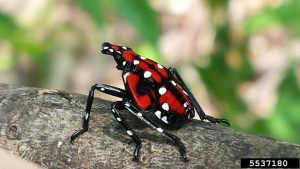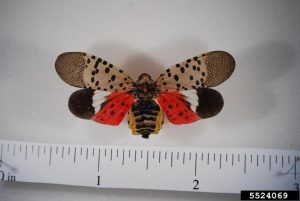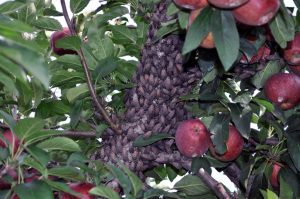Drum Roll: The Spotted Lanternfly
Southeastern Pennsylvania, the epicenter of spotted lanternfly’s arrival in 2014, might seem far enough away to give us in New York prep time for dealing with this new pest, a weak flyer that usually hops to get around. But with the spotted lanternfly (Lycorma delicatula—and SLF for short), all bets are off. After all, it took over Korea, whose climate is surprisingly like our own, in no time flat. And now it’s in Maryland. Delaware. Virginia. New Jersey.
New York’s first find happened to be dead. Blind dumb luck.

How anything so pretty could be so nasty boggles the mind. But it’s the nature of nature. Since ID’ing SLF correctly is key to good IPM, let’s start with the nymphs—the young-uns. In this case they come in two snazzy colors. The early-stage nymphs are straight-on black or, once they’ve molted, black and white—handsome devils or trendy fashionistas; take your pick. For late-stage nymphs (late-stage means they molted—again—and outgrew the skin they had after they hatched), add blobs of blood-red, and that critter looks ready to conquer the world.
Which it might.
Does that bright, traffic-light red signal toxicity, as it does for many other potential prey? Right now all I know is that birds have been seen throwing up after grabbing one for a snack—and yes, they are toxic to us.

Meanwhile, adult SLFs look positively benign. Lovely, in fact. Don’t believe it for a minute. These classy lads and lassies resemble butterflies or moths, but don’t believe that either—they are, you’ll recall, planthoppers; the name refers to its mode of locomotion.
Whatever. Spotted lanternflies have a destiny. Their natural expertise in the pole-vault isn’t their only way to get around. How many roads (think interstates especially) wend their way from southeastern Pennsylvania to points north, south, east and west? Lots.
Consider your car or camper, for starters. Firewood? You’d be slack-jawed at the degree to which firewood fits into the equation. Just the eggs alone—not easy to see with a cursory look—can easily hitch rides to new areas, meaning that New York is a mere hop, skip and a jump away. Trains, tractor trailers, wheel wells, the cargo hold in a jet—this pest doesn’t need to lay its eggs on organic matter. Planning a long-distance road trip? California, here we come.
“I don’t want to scare people,” says Dr. Surendra Dara, an IPM and crop advisor at the University of California, “but it has the potential to spread, and we do not have a biological-control agent.”
Which is why you, dear reader, are our eyes on the ground.
But wait. Other than toxicity, I haven’t even told you why to be alarmed about this critter. Grapes, apples, hops—these and more high-value crops rank in the billions for New York. Apples alone ring the register at about $317 million.
New York’s forestry crops are vital, too. Here’s what forest crops provide:
- jobs for 49,200 people with payrolls of over $1.6 billion;
- manufacturing, recreation and tourism providing over $11.0 billion to our economy;
- removing greenhouse gases from the atmosphere, sequestering carbon, and producing oxygen critical for all life on earth;
- filtering and buffering clean drinking water for millions of New Yorkers.
As our eyes on the ground, here’s what you need to know. Signs that spotted lanternfly are at our collective doorstep include:
- sap oozing or weeping from tiny open wounds on tree trunks;
- a yeasty smell (been near a brewery lately? That’s it);
- inch-long, brownish-gray egg masses—like waxy mud when new, brown and scaly when old
- heaps of honeydew under trees and vines and covered, often as not, with black sooty mold.

Besides fruit and hops, what’s at risk? Everything from willows to walnuts—and smooth-barked trees especially. But keep in mind that many a mature tree which, once it has packed on the pounds around its waist and takes on a decidedly rough or furrowed look, looks svelte and clean-cut while still relatively young. Go outside and look at any gently-furrowed tree, and chances are you’re looking at a host. For those areas where tree-of-heaven runs rife, well—you’re looking at what might be its most favorite host of all.
Though it’s hard to wrap your mind around, it sups on some—maybe all—field crops. “We’ve seen it in some of the grain crops that are out there, soybean and what have you,” said Fred R. Strathmeyer Jr., Pennsylvania’s deputy secretary of agriculture. “It’s able to feed on many, many different things.”
Now think about honeydew. Not the drink, not the melon; rather the stuff bugs secrete as they feed. A case of in one end, out the other as they move down the chow line. Although native insects also secrete honeydew, the size of the SLF and staggering numbers that congregate from place to place makes for a remarkable amount of honeydew. Parked your car beneath an infested tree? Time to clean off those sticky windshield wipers.
For sure—this sticky mess and the swarms of insects it attracts gets in the way of outdoor fun. In Pennsylvania, where SLF populations are the densest, people near the heart of the problem can’t go outside without getting honeydew on their hair, clothes, and whatever they’re carrying. At which point “outdoor” and “fun” no longer have all that much in common.
So that’s it in a nutshell and, for spotted lanternfly, all the news that’s fit to print. For now.
Wait … now for the late breaking news:
Lanternflies Eat Everything in Sight. The U.S. Is Looking Delicious …